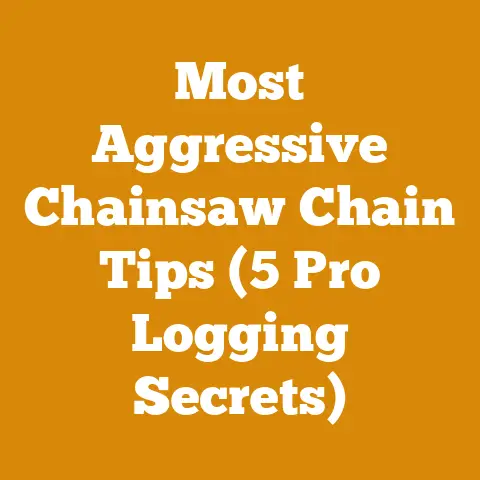Stihl and Echo Chainsaws: Best Picks for Portability (5 Pro Tips)
(Image: A split image. On one side, a burly logger struggles to maneuver a heavy, gas-powered chainsaw through a thick log. On the other, a woman easily trims branches with a lightweight, battery-powered chainsaw while smiling.)
Ah, chainsaws. The symphony of the woods, the smell of freshly cut timber, the satisfying thunk of a log splitting. But let’s be honest, choosing the right chainsaw can feel like navigating a tangled forest of options. And when portability is your top priority, the decision gets even trickier. You’re likely weighing the Stihl and Echo chainsaws, two titans in the industry, and trying to figure out which one offers the best balance of power and packability.
I’ve spent countless hours in the woods, from my early days helping my grandfather clear brush on his farm to managing larger-scale firewood operations. I’ve wrestled with heavy saws that left my arms aching for days and appreciated the agility of lighter models when navigating tricky terrain. I’ve learned that the “best” chainsaw isn’t always the most powerful; it’s the one that fits your specific needs and the unique demands of your projects.
This article isn’t just about comparing specs; it’s about understanding the real-world implications of those specs on your wallet and your workload. We’ll dive deep into the costs associated with owning and operating both Stihl and Echo chainsaws, factoring in everything from the initial purchase price to ongoing maintenance and fuel consumption. We’ll also explore how choosing the right saw can significantly impact your overall budget for firewood preparation or small-scale logging operations.
Think of it as your guide to making an informed decision, saving money, and avoiding the common pitfalls I’ve personally encountered (and learned from!) over the years. Let’s get started!
Stihl vs. But what exactly does “portable” mean, and how do these two brands stack up in terms of weight, size, and power-to-weight ratio?
Defining Portability: More Than Just Weight
Portability isn’t just about how much a chainsaw weighs. It’s a combination of factors that affect how easily you can carry, operate, and maneuver the saw, especially in challenging environments. These factors include:
- Weight: Obviously, a lighter saw is easier to carry for extended periods.
- Size: A compact saw is easier to maneuver in tight spaces.
- Balance: A well-balanced saw reduces fatigue and improves control.
- Ergonomics: Comfortable handles and intuitive controls make the saw easier to use.
Stihl’s Portable Powerhouses
Stihl is renowned for its robust construction and powerful engines. Their portable options often pack a surprising punch for their size. Some popular models known for their portability include:
- Stihl MS 170: A lightweight, entry-level gas-powered chainsaw ideal for occasional use and light pruning.
- Stihl MS 180: A slightly more powerful version of the MS 170, suitable for cutting small trees and firewood.
- Stihl MSA 161 T: A battery-powered top-handle chainsaw designed for arborists and professionals who need a lightweight, maneuverable saw.
- Stihl MSA 220 C-B: Stihl’s most powerful battery-powered chainsaw.
Echo’s Lightweight Champions
Echo is known for its reliability and affordability. Their portable chainsaws are often lighter than comparable Stihl models, making them a popular choice for homeowners and occasional users. Notable models include:
- Echo CS-310: A lightweight, gas-powered chainsaw perfect for homeowners and light-duty tasks.
- Echo CS-352: A more powerful version of the CS-310, suitable for cutting larger trees and firewood.
- Echo DCS-5000: A battery-powered chainsaw known for its long run time and ease of use.
- Echo CS-271T: A gas-powered top-handle chainsaw designed for arborists and tree care professionals.
Head-to-Head Comparison: Weight and Power
Let’s take a closer look at the weight and power specifications of some comparable Stihl and Echo models:
| Model | Brand | Power Source | Weight (lbs) | Engine Size (cc) | Bar Length (in) | Typical Use |
|---|---|---|---|---|---|---|
| MS 170 | Stihl | Gas | 9.9 | 30.1 | 16 | Light pruning, small firewood |
| CS-310 | Echo | Gas | 8.8 | 30.5 | 14 | Light pruning, small firewood |
| MS 180 | Stihl | Gas | 10.8 | 31.8 | 16 | Small trees, firewood |
| CS-352 | Echo | Gas | 10.6 | 34.4 | 16 | Small trees, firewood |
| MSA 161 T | Stihl | Battery | 4.6 (w/o battery) | N/A | 12 | Arborists, tree care professionals |
| DCS-5000 | Echo | Battery | 11.7 (w/ battery) | N/A | 18 | General cutting, firewood |
Data Sources: Manufacturer websites (Stihl.com, Echo-USA.com)
As you can see, Echo often has a slight edge in terms of weight, while Stihl tends to offer slightly more power in some comparable gas models. However, the battery-powered options are becoming increasingly competitive, with both brands offering models with impressive power and run times.
5 Pro Tips for Choosing a Portable Chainsaw
Now that we’ve explored the key considerations for portability and compared some popular Stihl and Echo models, let’s dive into five pro tips to help you make the right choice for your specific needs:
Pro Tip #1: Assess Your Cutting Needs
Before you even start looking at specific chainsaw models, take a moment to honestly assess your cutting needs. What types of projects will you be tackling? How often will you be using the saw? What size trees or logs will you be cutting?
- Occasional Use (Light Pruning, Small Firewood): If you only need a chainsaw for occasional light tasks, a lightweight gas-powered model like the Echo CS-310 or Stihl MS 170 might be sufficient. Battery-powered options are also worth considering for their ease of use and low maintenance.
- Regular Use (Firewood, Small Trees): If you plan to use the chainsaw more frequently for cutting firewood or small trees, you’ll need a more powerful model like the Echo CS-352 or Stihl MS 180. Consider a battery-powered option with a longer run time if you prefer the convenience of electric power.
- Professional Use (Arborists, Tree Care): If you’re a professional arborist or tree care worker, you’ll need a top-handle chainsaw like the Stihl MSA 161 T or Echo CS-271T. These saws are designed for maneuverability and precision in tight spaces.
Understanding your cutting needs will help you narrow down your options and avoid buying a chainsaw that’s either underpowered or overkill for your projects.
Pro Tip #2: Consider the Power Source
The power source is a critical factor to consider when choosing a portable chainsaw. Gas-powered chainsaws offer more power and longer run times, while battery-powered chainsaws are lighter, quieter, and easier to maintain.
- Gas-Powered: Gas-powered chainsaws are the traditional choice for most users. They offer more power and longer run times than battery-powered models. However, they also require more maintenance, including mixing fuel, cleaning the carburetor, and replacing spark plugs. They also produce emissions and can be noisy.
- Battery-Powered: Battery-powered chainsaws are becoming increasingly popular due to their ease of use, low maintenance, and quiet operation. They’re also more environmentally friendly than gas-powered models. However, they typically offer less power and shorter run times. The initial cost of a battery-powered chainsaw can also be higher, as you’ll need to purchase a battery and charger separately.
Cost Analysis: Gas vs. Battery
Let’s break down the costs associated with gas-powered and battery-powered chainsaws:
| Cost Category | Gas-Powered Chainsaw | Battery-Powered Chainsaw |
|---|---|---|
| Initial Purchase Price | Lower (e.g., $150 – $300) | Higher (e.g., $250 – $500 + battery and charger) |
| Fuel Costs | Ongoing (gasoline, 2-cycle oil) | None |
| Maintenance Costs | Higher (spark plugs, air filters, carburetor cleaning) | Lower (chain sharpening, occasional lubrication) |
| Environmental Impact | Higher (emissions, noise pollution) | Lower (zero emissions, quieter operation) |
| Run Time | Longer (refuel as needed) | Limited by battery capacity (requires recharging or swapping) |
Example:
Let’s say you use your chainsaw for 20 hours per year.
- Gas-Powered: Fuel costs might be around $50 per year (depending on fuel prices and chainsaw efficiency). Maintenance costs might be around $30 per year.
- Battery-Powered: Fuel costs are $0. Maintenance costs might be around $10 per year. However, you’ll need to factor in the cost of replacing the battery every few years (around $100 – $200).
Over a 5-year period, the total cost of ownership for a gas-powered chainsaw might be lower than a battery-powered chainsaw if you factor in the initial purchase price and battery replacement costs. However, the battery-powered chainsaw will be more convenient to use and better for the environment.
Pro Tip #3: Prioritize Ergonomics
Ergonomics is often overlooked, but it’s crucial for preventing fatigue and injuries. A chainsaw with a comfortable handle, good balance, and intuitive controls will be much easier to use for extended periods.
- Handle Design: Look for a chainsaw with a comfortable, ergonomic handle that fits your hand well. Some chainsaws have padded handles to reduce vibration and improve grip.
- Balance: A well-balanced chainsaw will be easier to control and maneuver. The weight should be evenly distributed between the front and rear handles.
- Vibration Reduction: Chainsaws produce a lot of vibration, which can lead to fatigue and hand-arm vibration syndrome (HAVS). Look for a chainsaw with a good vibration reduction system.
- Controls: Make sure the controls are easy to reach and operate. The throttle, chain brake, and on/off switch should be intuitive and responsive.
Personal Experience:
I once used a chainsaw with a poorly designed handle for an entire day. By the end of the day, my hands were numb and my arms were aching. I learned the hard way that ergonomics is not something to be ignored.
Pro Tip #4: Don’t Skimp on Safety Features
Safety should always be your top priority when operating a chainsaw. Look for models with essential safety features like:
- Chain Brake: A chain brake is a safety device that stops the chain from rotating in the event of a kickback.
- Hand Guard: A hand guard protects your hand from flying debris and contact with the chain.
- Throttle Lockout: A throttle lockout prevents the chain from accidentally engaging when the saw is idling.
- Anti-Vibration System: An anti-vibration system reduces vibration and minimizes the risk of HAVS.
Safety Gear is Essential:
In addition to the safety features on the chainsaw itself, you should always wear appropriate safety gear, including:
- Eye Protection: Safety glasses or a face shield to protect your eyes from flying debris.
- Hearing Protection: Earplugs or earmuffs to protect your hearing from the loud noise of the chainsaw.
- Gloves: Heavy-duty gloves to protect your hands from cuts and abrasions.
- Chaps: Chainsaw chaps to protect your legs from accidental cuts.
- Helmet: A helmet to protect your head from falling branches or debris.
Pro Tip #5: Factor in Maintenance Costs
Chainsaws require regular maintenance to keep them running smoothly and safely. Factor in the cost of maintenance when making your purchase decision.
- Gas-Powered Chainsaws: Gas-powered chainsaws require more maintenance than battery-powered models. You’ll need to regularly clean the air filter, replace the spark plug, and clean the carburetor. You’ll also need to mix fuel and oil, which can be messy and time-consuming.
- Battery-Powered Chainsaws: Battery-powered chainsaws require less maintenance. You’ll need to keep the chain lubricated and sharpen it regularly. You may also need to replace the battery every few years.
- Chain Sharpening: Regardless of the power source, you’ll need to sharpen the chain regularly to maintain optimal cutting performance. You can sharpen the chain yourself with a file or take it to a professional.
Cost Analysis: Maintenance Tools
Here’s a breakdown of the costs associated with chainsaw maintenance tools:
| Tool | Description | Cost (Approximate) |
|---|---|---|
| Chainsaw File Kit | Includes files, depth gauge, and guide | $20 – $50 |
| Chain Grinder | Electric tool for sharpening chains | $50 – $200 |
| Bar Oil | Lubricates the chain and bar | $10 – $20 per gallon |
| Air Filter | Filters air entering the engine | $5 – $15 |
| Spark Plug | Ignites the fuel mixture in the engine | $3 – $10 |
| Carburetor Cleaner | Cleans the carburetor to improve engine performance | $5 – $15 |
Budgeting for Your Wood Processing or Firewood Preparation Project
Now that we’ve explored the factors to consider when choosing a portable chainsaw, let’s dive into budgeting for your overall wood processing or firewood preparation project.
Acknowledge the Variable Factors
Before you start crunching numbers, it’s essential to acknowledge the variable factors that can affect your project costs. These factors include:
- Wood Type: Different wood species have different densities and drying times, which can affect your labor costs and drying time.
- Location Accessibility: If your wood source is difficult to access, you’ll need to factor in additional transportation costs.
- Seasonality: Wood prices and availability can fluctuate depending on the season.
- Project Scale: The size of your project will obviously affect your overall costs.
Break Down the Cost Components
To create an accurate budget, you need to break down all the cost components of your project. These components typically include:
- Timber Purchase or Harvesting Costs: This includes the cost of purchasing timber or the cost of harvesting trees from your own property.
- Tool Costs: This includes the cost of purchasing or renting a chainsaw, splitter, and other necessary tools.
- Tool Maintenance: This includes the cost of maintaining your tools, such as chain sharpening, oil changes, and repairs.
- Labor Wages: If you’re hiring a logging crew or firewood handlers, you’ll need to factor in their wages.
- Transportation Costs: This includes the cost of transporting timber or firewood from the source to your processing location.
- Permits (If Applicable): Depending on your location and the scale of your project, you may need to obtain permits for harvesting or transporting timber.
- Drying Costs: If you’re preparing firewood, you’ll need to factor in the cost of drying the wood. This may include the cost of building a wood shed or using a kiln.
Industry Benchmarks and Statistical Data
To help you estimate your costs, here are some industry benchmarks and statistical data:
- Average Price per Cord of Firewood: The average price per cord of firewood in the United States ranges from $200 to $400, depending on the location and wood species. (Source: Local firewood suppliers and online marketplaces)
- Timber Prices: Timber prices vary widely depending on the species, quality, and location. Contact local sawmills or timber brokers for current pricing information.
- Equipment Rental Fees: Chainsaw rental fees typically range from $30 to $50 per day. Wood splitter rental fees typically range from $50 to $100 per day. (Source: Local equipment rental companies)
- Labor Wages: Logging crew wages typically range from $15 to $30 per hour. Firewood handler wages typically range from $12 to $20 per hour. (Source: U.S. Bureau of Labor Statistics)
Practical Tips for Cost Optimization
Here are some practical tips for optimizing your costs:
- Source Wood Locally: Sourcing wood locally can reduce transportation costs.
- Buy in Bulk: Buying timber or firewood in bulk can often result in lower prices.
- Rent Equipment: Renting equipment instead of buying it can save you money if you only need it for occasional use.
- Do It Yourself: If you’re comfortable with the work, doing some of the labor yourself can save you money on wages.
- Dry Wood Efficiently: Drying wood efficiently can reduce drying time and prevent spoilage.
- Negotiate Prices: Don’t be afraid to negotiate prices with suppliers and contractors.
- Plan Ahead: Planning your project carefully can help you avoid unexpected costs.
Relevant Calculations and Formulas
Here are some relevant calculations and formulas that can help you estimate your costs:
- Calculating Volume of Logs in Board Feet: Board feet = (Length in feet x Width in inches x Thickness in inches) / 12
- Calculating Volume of Firewood in Cords: A cord is a stack of wood that measures 4 feet high, 4 feet wide, and 8 feet long, or 128 cubic feet.
- Estimating Drying Time: Drying time depends on the wood species, moisture content, and climate. As a general rule, firewood needs to dry for at least six months to reach a moisture content of 20% or less.
Case Study: Budgeting for a Small Firewood Business
Let’s consider a case study of someone starting a small firewood business.
Project Goal: To produce and sell 100 cords of firewood per year.
Cost Breakdown:
- Timber Purchase: $5,000 (assuming $50 per cord for standing timber)
- Chainsaw Purchase: $300 (Stihl MS 180)
- Wood Splitter Rental: $1,000 (assuming $100 per day for 10 days)
- Labor Wages: $10,000 (assuming $15 per hour for 667 hours)
- Transportation Costs: $1,000
- Permits: $500
- Maintenance: $200
Total Costs: $17,000
Revenue:
- Sales: $30,000 (assuming $300 per cord)
Profit: $13,000
This case study shows that a small firewood business can be profitable, but it’s essential to carefully budget your costs and manage your operations efficiently.
Actionable Takeaways and Next Steps
Choosing the right chainsaw and budgeting for your wood processing or firewood preparation project can seem daunting, but by following these tips, you can make informed decisions and avoid common pitfalls. Remember to:
- Assess your cutting needs and choose a chainsaw that’s appropriate for your projects.
- Consider the power source and weigh the pros and cons of gas-powered and battery-powered models.
- Prioritize ergonomics to prevent fatigue and injuries.
- Don’t skimp on safety features and always wear appropriate safety gear.
- Factor in maintenance costs and budget for regular maintenance.
- Acknowledge the variable factors that can affect your project costs.
- Break down the cost components of your project and create an accurate budget.
- Use industry benchmarks and statistical data to estimate your costs.
- Implement practical tips for cost optimization.
Next Steps:
- Research specific Stihl and Echo chainsaw models that meet your needs and budget.
- Visit a local dealer to try out different models and get expert advice.
- Create a detailed budget for your wood processing or firewood preparation project.
- Gather quotes from suppliers and contractors.
- Develop a project plan that outlines your goals, timelines, and resources.
- Start cutting!
Final Thoughts: The Symphony of the Woods Awaits
Armed with the right knowledge and tools, you can confidently navigate the world of chainsaws and wood processing. Remember, it’s not just about the power of the saw; it’s about the skill of the operator and the joy of working with wood. Whether you’re felling trees in the forest or splitting firewood in your backyard, embrace the challenge, respect the power of the tools, and enjoy the symphony of the woods. And, most importantly, stay safe!






